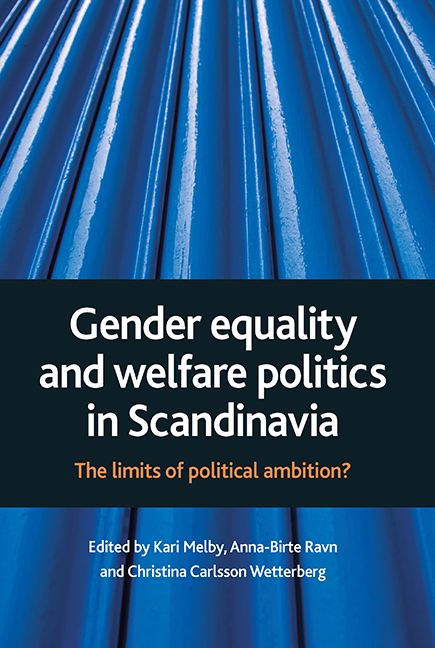Book contents
- Frontmatter
- Contents
- List of tables
- Preface
- Notes on contributors
- A Nordic model of gender equality? Introduction
- Part One Meanings of gender equality in Scandinavian welfare policy
- Part Two Current challenges: competing discourses on gender equality
- Postscript Gender, citizenship and social justice in the Nordic welfare states: a view from the outside
- Postscript Future research on gender equality in the Scandinavian countries
- Appendix Tables 1-10
- Index
A Nordic model of gender equality? Introduction
Published online by Cambridge University Press: 21 January 2022
- Frontmatter
- Contents
- List of tables
- Preface
- Notes on contributors
- A Nordic model of gender equality? Introduction
- Part One Meanings of gender equality in Scandinavian welfare policy
- Part Two Current challenges: competing discourses on gender equality
- Postscript Gender, citizenship and social justice in the Nordic welfare states: a view from the outside
- Postscript Future research on gender equality in the Scandinavian countries
- Appendix Tables 1-10
- Index
Summary
The challenges of today
The overall objective of this book is to analyse the meanings of gender that underpin policies for the achievement of gender equality in the Scandinavian welfare states, ie Denmark, Norway and Sweden. The book focuses on similarities as well as differences between the countries and discusses the relevance of talking about a Nordic model. Different meanings of gender equality and the relationship between discourse and practice are analysed. The book is interdisciplinary and includes historical perspectives and comparative analyses. Its primary focus is on reforms and legislation related to the family, so crucial to the understanding of the welfare state. The book is policy oriented, but is also directed towards a broader discourse, and it focuses on the relationship between equality policy and family policy in the Scandinavian countries. The ambition of gender equality has been more explicitly expressed and applied in the Scandinavian countries than in other countries of Europe. But gender equality in the early 20th century to a great extent meant equality based on gender difference. The book raises the question whether the hallmark of the Scandinavian welfare model is a special combination of gender equality and gender differentiation. It stresses the importance of viewing the concept of equality in its historical context and investigates the changing meanings of equality based on sameness and/or gender difference.
The analysis takes its point of departure in a period when gender-equality policies were formulated for the first time. Gender equality – in the sense of formal equal rights – had already achieved increasing political support in the Nordic countries during the last decades of the 19th century, and around 1920 women had obtained formal equal rights with men in terms of education and government posts, voting and political positions. Between 1909 and 1929 the marriage legislation in all Nordic countries was also thoroughly reformed, modernising the institution of marriage, enhancing women's individual rights and ending the husband's legal power over his wife. The reformed legislation also gave married women the obligation to provide for the family, which was unique, as seen in a European perspective, and questions the application of a male-breadwinner model to this formative period of the Scandinavian welfare states.
- Type
- Chapter
- Information
- Gender Equality and Welfare Politics in ScandinaviaThe Limits of Political Ambition?, pp. 1 - 24Publisher: Bristol University PressPrint publication year: 2008



